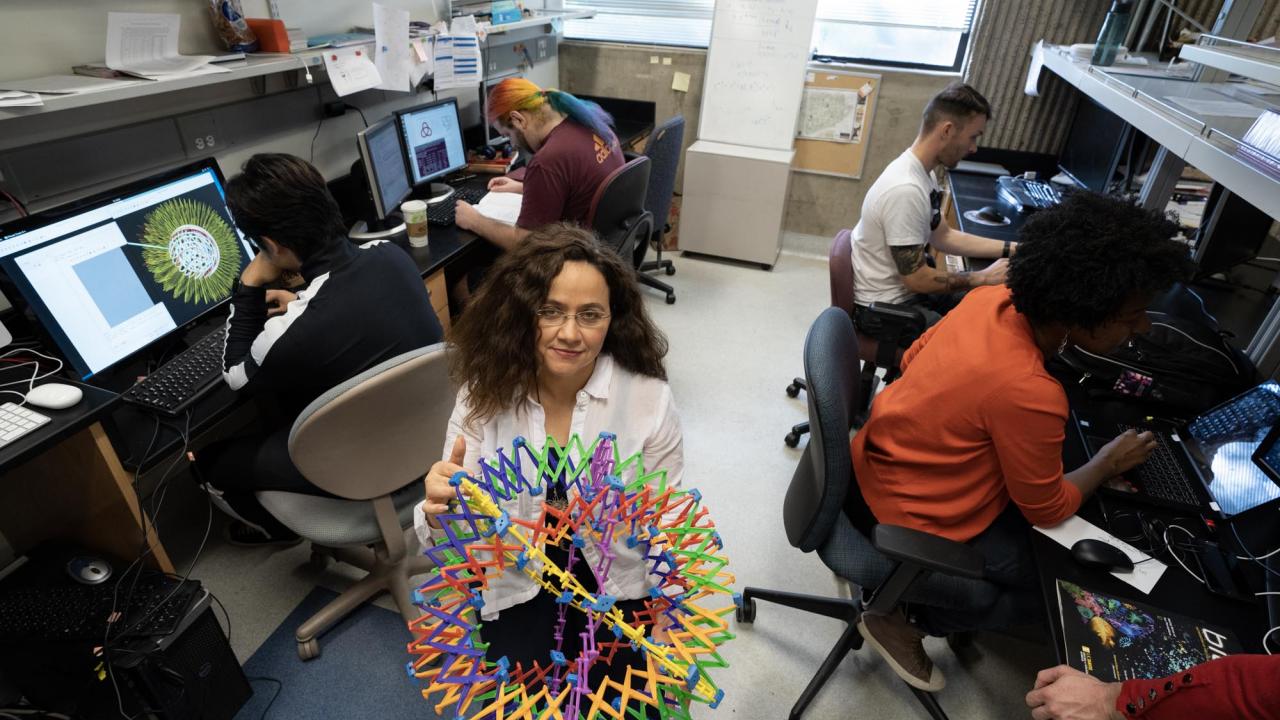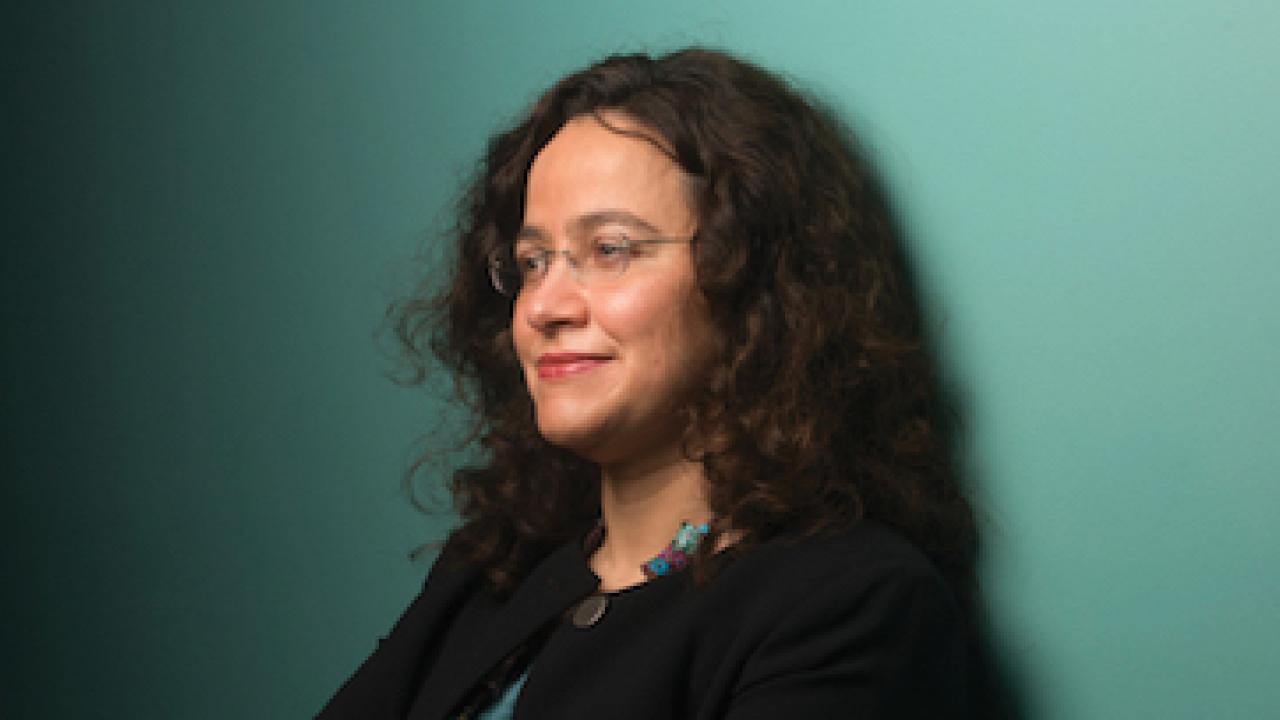
Discovering Curiosity: The Tangled Fate of Math and Biology with Professor Mariel Vazquez
Quick Summary
- From pocketed headphones to carelessly packed garden hoses, knots find ways to manifest
- Our DNA molecules can get tied into knots too
- Professor Mariel Vazquez applies her training in mathematics to fundamental questions about DNA structure and functionality
Professor Mariel Vazquez fished out the headphones and placed them atop the desk in her office in the Mathematical Sciences Building. She started uncoiling the mess.
“Mathematicians love the beauty of knots,” said Vazquez. “They love the underlying structures that can be very abstract and very complicated.”
She laid the cord as flat as she could, straightening it across the desk. A tangled loop caught her eye.
“Look, there’s a knot,” she said. “It formed there by itself; I didn’t tie it.”
Knots are a part of nature. From pocketed headphones to carelessly packed garden hoses, they find ways to manifest in strings and loops. This isn’t just a truth of mathematics; it’s a truth of biology. In fact, DNA molecules can also get tied into knots.

2020 Class of the Fellows of the American Mathematical Society
Professor Mariel Vazquez was elected as a 2020 fellow, honored for contributions in research and outreach at the interface of topology and molecular biology, and for service to the mathematical community, in particular to underrepresented group.
According to Vazquez, if you straightened out the chromosomes found inside a human cell nucleus, you’d have a six-foot-long chain. To fit inside the nucleus, this chain has to be packaged in a compact but functional manner. Enzymes snip and repair this DNA chain to fulfill different functions. In the process, they create different entanglements.
“The chromosomes fit in a tiny, tiny environment and yet, they are accessible for anything that the cell needs,” said Vazquez. “The enzymes and the cellular structures are managing a very careful packaging of the DNA, where each part of the sequence is accessible for processes like replication and transcription.”
The study of such looped shapes is called topology, and Vazquez applies her training in this area of mathematics to fundamental questions about DNA structure and functionality.
“We use tools from low-dimensional topology to study the entanglement of DNA in small environments and to study the mechanism of enzymes that bind to DNA molecules and change their geometry and topology,” said Vazquez. “We want to come up with quantification of the entanglement with models on how this process works.”

Finding a knot that sticks
As a child, Vazquez loved to count. She’d count tiles and pebbles, finding patterns in the world around her. This pattern-finding predilection extended to her academic interests. Algebra, geometry and calculus all naturally held Vazquez’s attention. In high school, she took a biology class and learned the central dogma of molecular biology (DNA encodes RNA, RNA encodes proteins).
“At that moment, I decided I want to do something that combines mathematics and biology,” said Vazquez.
Vazquez enrolled in the National Autonomous University of Mexico, located in Mexico City. She described higher education in Mexico as a mixture between the U.S. and European university systems. First-year students, she said, must declare a discipline of study from the get-go. Faced with a tough choice between math and biology, Vazquez chose math.
During her early college years, Vazquez found herself invigorated more and more by topics traditionally labeled as pure mathematics but felt discouraged by the unfounded notion that pure mathematics is divorced from application. One day, Vazquez saw a poster advertising a series of lectures about knots and DNA. While she’d always wanted to combine math and biology, this was the first time Vazquez had seen such interdisciplinary research in action. She knew she had to get involved.

Read Professor Mariel Vazquez's piece in The Conversation
As a mathematician and a biologist, I am interested in how mathematics can describe the many shapes of DNA, as well as cellular processes like DNA replication. The answers to these questions inspire new mathematics and possibly a better understanding of the molecule of life. shows how DNA twists, turns and unzips
Untangling DNA chains
After receiving her undergraduate degree, Vazquez headed to Florida State University in Tallahassee, where she enrolled in a mathematics Ph.D. program. She studied with De Witt Sumners, now a distinguished professor of mathematics with the university. With Sumners, Vazquez started using mathematical methods to better understand how DNA recombination affects DNA topology. She was part of the Program in Mathematics and Molecular Biology (PMMB), a national training program.
“As part of PMMB there were many people from many different disciplines doing interdisciplinary research, applying mathematics to molecular biology,” said Vazquez, who noted that answering the big questions of biology requires interdisciplinary approaches.
Following graduation, Vazquez secured a postdoctoral research position at UC Berkeley in a lab studying the effects of radiation on DNA. Like snipping enzymes, radiation can cut DNA, damaging it in the process. Vazquez spent her postdoc learning about DNA repair pathways and the biophysical mechanisms of repair induced by radiation events.
After five years of research, Vazquez started researching and teaching at San Francisco State University. In 2014, she joined the UC Davis faculty with a dual appointment as a professor of mathematics as well as microbiology and molecular genetics. She was part of the first cohort of academics brought to UC Davis by the Center for the Advancements of Multicultural Perspectives on Science (CAMPOS), an initiative funded by the UC Davis ADVANCE grant that’s now run by the Office of Diversity, Equity and Inclusion.
Five years later, Vazquez was named faculty director of CAMPOS.
Uniting languages of science

The makeup of the Topological Molecular Biology lab, which Vazquez runs with Professor F. Javier Arsuaga, of the Department of Molecular and Cellular Biology and the Department of Mathematics, at UC Davis reflects the university’s commitments to diversity and interdisciplinary research. Ph.D. students in her lab come from a variety of graduate groups, including Integrative Genetics and Genomics, Mathematics, Physics and Biostatistics.
“We try to bring together people who traditionally speak different languages, scientific or otherwise,” said Vazquez. “The moment you have diversity in a group, there are better ideas.”
As biology becomes more quantitative, Vazquez said life sciences students can’t afford to balk at mathematics.
“There’s a massive amount of data pouring out of equipment in the labs,” she said. “You need to be quantitative to know how to parse that information and to trust that what you’re doing is meaningful.”
Vazquez’s research literally unravels the mystery of how DNA is packaged inside our cells and how changes to its shape—and the myriad molecules influencing it—work in healthy and diseased cells.
“We start with an important problem from biology and then we translate it into a problem in mathematics, computer science, statistics or physics, we work on it, but always keeping an eye on the original motivation and the relevance to biology,” she said.
Vazquez and her team’s quantitative understanding of the cellular mechanisms acting on DNA mechanisms could help inform translational research on diseases that manifest first at the molecular level.
“The ultimate goal of my research is to uncover the multiple shapes of DNA and to achieve a deep understanding of the contributions of DNA topology to a healthy cell,” she said.

